Synapses are specialized junctions by which a stimulus is transmitted from a neuron to its target cell. Artificially stimulated axons can propagate a wave of depolarization in either direction, but the signal can travel in only one direction across a synapse, which functions as a unidirectional signal valve. Synapses are named according to the structures they connect, eg, axodendritic, axosomatic, axoaxonic, and dendrodendritic synapses. The 3 major structural components of each synapse are the pre and postsynaptic membranes and the synaptic cleft that separates them.
A. Presynaptic Membrane: This is the part of the terminal bouton membrane closest to the target cell. It consists of an electron-dense thickening into which insert many short intermediate filaments, as in a hemidesmosome. On stimulation, neurosecretory vesicles in the bouton fuse with the presynaptic membrane and exocytose their neurotransmitters into the synaptic cleft. Neurosecretory vesicles are present only in the presynaptic component of the junction. The vesicle membrane added to the presynaptic membrane is recycled by endocytosis of the mem brane lateral to the synaptic cleft. Intact vesicles do not cross the synaptic cleft.
B. Synaptic Cleft (Synaptic Gap): This is a fluid-filled space, generally 20 nm wide, between the pre- and postsynaptic membranes. It is shielded from the rest of the extracellular space by supporting cell processes and basal lamina material that binds the pre- and postsynaptic mem branes together. Some clefts are traversed by dense filaments that link the membranes and perhaps guide neurotransmitters across the gap.
C. Postsynaptic Membrane: This is a thickening of the plasma membrane of the next neuron or target cell leg, muscle). It resembles the presynaptic membrane but also contains receptors for neurotransmitters. When enough receptors are occupied, hydrophilic channels open, resulting in depolarization of the postsynaptic membrane. Neurotransmitter leg, acetylcholine) remaining in the cleft after stimulation of the postsynaptic neuron (or other target cell) is degraded by enzyme leg, acetylcholinesterase) in the cleft. Degradation products are endocytosed by coated pits in the membrane of the bouton, lateral to the presynaptic thickening. Removal of excess transmitter allows the postsynaptic membrane to reestablish its resting spotential and prevents continuous firing of the postsynaptic neuron in response to a single stimulus.
SYNAPSES (CHEMICAL)
Subscribe to:
Posts (Atom)
